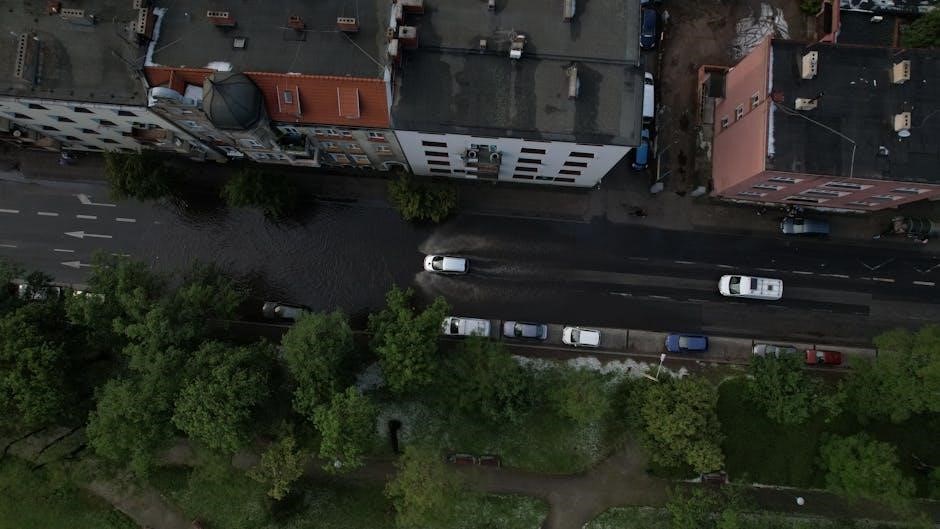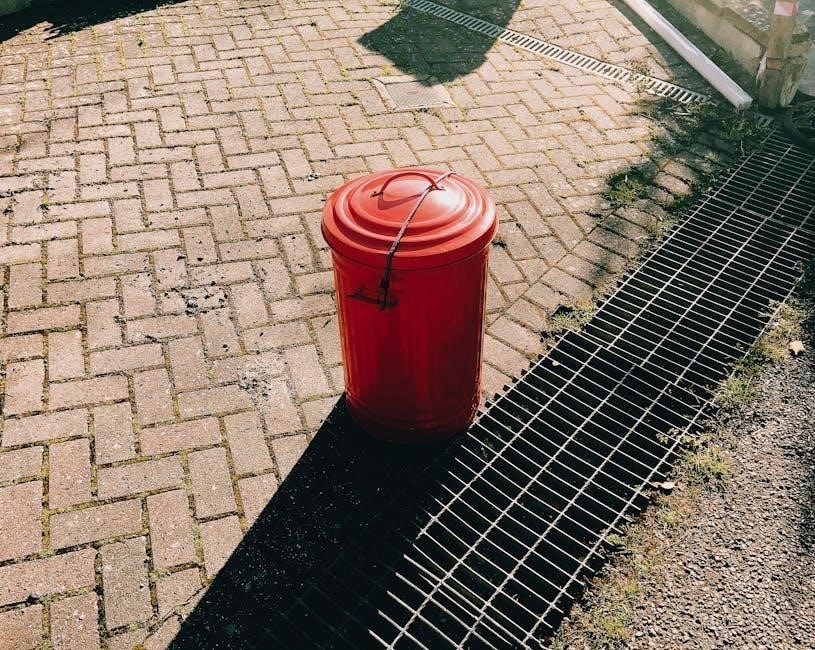The City of Columbus Stormwater Drainage Manual provides a comprehensive guide for managing stormwater effectively‚ ensuring compliance with local and state regulations and promoting sustainable drainage practices․
1․1 Purpose and Scope of the Manual
The purpose of the City of Columbus Stormwater Drainage Manual is to provide a structured approach to managing stormwater effectively‚ ensuring compliance with local and state regulations․ The manual outlines design standards‚ best management practices (BMPs)‚ and maintenance requirements for stormwater systems․ Its scope covers regulatory frameworks‚ hydrologic and hydraulic design criteria‚ and green infrastructure solutions․ The manual serves as a resource for developers‚ engineers‚ and property owners to ensure sustainable and environmentally responsible stormwater management practices․ It also addresses illicit discharges and watershed-scale planning to protect water quality and public health in Columbus․
1․2 Importance of Stormwater Management in Columbus
Effective stormwater management is crucial for protecting Columbus’ water quality‚ reducing flooding‚ and safeguarding public health․ Proper management prevents pollution from entering waterways‚ mitigates erosion‚ and maintains infrastructure integrity․ Columbus’ urban environment makes stormwater control essential to prevent combined sewer overflows and ensure community safety․ The manual emphasizes sustainable practices to address these challenges‚ promoting a balanced approach between development and environmental stewardship․ By adhering to the manual’s guidelines‚ Columbus can maintain its water resources and support long-term environmental and economic health․

Regulatory Framework
The Regulatory Framework outlines the legal and procedural standards governing stormwater management in Columbus‚ ensuring compliance with local codes and state environmental regulations․
2․1 Columbus City Code 1145․11 and 1145․81
Columbus City Codes 1145․11 and 1145․81 establish specific requirements for stormwater drainage systems‚ including design standards‚ maintenance obligations‚ and prohibited discharges to ensure environmental protection and public safety․
2․2 Compliance with OEPA Laws and Regulations
Compliance with Ohio Environmental Protection Agency (OEPA) laws and regulations is mandatory for all stormwater management activities in Columbus․ These regulations ensure that stormwater systems are designed and maintained to protect water quality‚ reduce pollution‚ and mitigate the impact of urban runoff․ Adherence to OEPA standards is crucial for obtaining permits and avoiding penalties‚ and the manual provides detailed guidance on meeting these requirements effectively․
2․3 Construction General Permit Requirements
The Construction General Permit (CGP) requirements ensure that stormwater management practices during construction activities meet environmental standards․ These permits regulate site runoff‚ erosion control‚ and sediment management to protect water quality․ The manual outlines specific measures to comply with CGP requirements‚ including the implementation of best management practices (BMPs) and regular inspections․ Proper documentation and reporting are also emphasized to maintain compliance and avoid penalties․ Adherence to these requirements is essential for minimizing environmental impact and ensuring sustainable stormwater management during construction projects in Columbus․

Stormwater Drainage System Components
The stormwater drainage system in Columbus includes components like pipes‚ channels‚ and structural BMPs‚ designed to manage runoff efficiently and protect water quality through effective maintenance practices․
3․1 Overview of the Stormwater Drainage Infrastructure
The stormwater drainage infrastructure in Columbus is a network of pipes‚ channels‚ and detention ponds designed to manage urban runoff․ It includes structural BMPs like catch basins and bioswales․ These components work together to reduce flooding and improve water quality․ Regular maintenance is essential to ensure system efficiency․ The infrastructure supports both quantity and quality control measures‚ aligning with local regulations and environmental goals․ This integrated approach helps protect the city’s waterways and promotes sustainable drainage practices․
3․2 Structural Best Management Practices (BMPs)
Structural BMPs in Columbus are physical systems designed to manage stormwater runoff․ Examples include detention ponds‚ bioswales‚ and permeable pavements․ These structures help reduce runoff velocity and capture pollutants‚ improving water quality․ They are often integrated into urban landscapes to enhance aesthetics while serving functional purposes․ Regular maintenance of these BMPs ensures their effectiveness in mitigating flooding and protecting waterways․ Compliance with local regulations‚ such as Columbus City Code 1145․11 and 1145․81‚ is critical for their implementation․ The manual provides detailed guidelines and tools for designing and maintaining these structures effectively․
3․3 Maintenance Requirements for Stormwater Systems
Regular maintenance of stormwater systems in Columbus is essential to ensure their effectiveness․ This includes routine inspections‚ debris removal‚ and cleaning of catch basins‚ pipes‚ and detention ponds․ Maintenance schedules must align with seasonal changes to address leaf litter and snowmelt․ Compliance with Columbus City Code 1145․11 and 1145․81 ensures systems function as designed․ Proper upkeep prevents clogging‚ reduces flooding risks‚ and maintains water quality․ The manual outlines specific tasks and frequencies for maintaining structural BMPs and drainage infrastructure‚ emphasizing the importance of proactive management to safeguard public health and environmental sustainability․

Design Standards and Guidelines
The manual outlines design criteria for Columbus’ stormwater systems‚ ensuring compliance with local codes and environmental regulations to manage runoff effectively and protect water quality․
4․1 Hydrologic and Hydraulic Design Criteria
The hydrologic and hydraulic design criteria in the City of Columbus Stormwater Drainage Manual ensure that stormwater systems are designed to manage runoff effectively․ These criteria are based on hydrologic analysis and hydraulic calculations to determine peak flow rates‚ drainage areas‚ and system capacity․ The manual specifies design storms‚ rainfall intensities‚ and runoff coefficients to guide engineers in creating efficient stormwater conveyance systems․ Compliance with these criteria ensures that infrastructure can handle extreme weather events while protecting water quality and preventing flooding․ The guidelines also emphasize the use of advanced modeling tools for accurate hydraulic analysis and system design․
4․2 Stormwater Quality and Quantity Control Measures
The City of Columbus Stormwater Drainage Manual outlines measures to manage both the quality and quantity of stormwater runoff․ These measures aim to reduce pollution and mitigate the impact of urbanization on waterways․ Techniques include the use of green infrastructure‚ such as rain gardens and permeable pavements‚ to infiltrate and filter stormwater․ Structural BMPs‚ like detention ponds and bioswales‚ are also emphasized to control runoff volume and improve water quality․ The manual provides design guidelines to ensure these practices effectively manage stormwater quantity and quality‚ aligning with local and state environmental regulations to protect aquatic ecosystems and public health․
4․3 Green Infrastructure and Low Impact Development (LID)
Green infrastructure and Low Impact Development (LID) are integral to Columbus’ stormwater management strategy․ These practices mimic natural hydrologic processes by infiltrating‚ filtering‚ and slowing down stormwater runoff․ Techniques include permeable pavements‚ rain gardens‚ green roofs‚ and bioswales․ LID emphasizes preserving natural terrain and minimizing impervious surfaces to reduce runoff volume and improve water quality․ The manual provides design guidelines and incentives for incorporating these sustainable practices into urban projects‚ promoting environmental benefits and community resilience while aligning with regulatory requirements and watershed protection goals․

Stormwater Management Practices
Stormwater management practices in Columbus focus on implementing effective strategies to mitigate runoff impacts‚ protect water quality‚ and align with community and environmental objectives․
5․1 Non-Structural BMPs for Stormwater Management
Non-structural BMPs focus on practices that reduce stormwater runoff without physical infrastructure․ These include public education‚ zoning ordinances‚ and routine inspections to prevent pollution․ By promoting land-use strategies‚ such as preserving green spaces and implementing infiltration techniques‚ these BMPs enhance water quality and mitigate flooding․ They emphasize community engagement and proactive measures to manage stormwater effectively‚ ensuring compliance with local regulations and fostering environmental stewardship․ These practices are cost-effective and integral to sustainable urban planning in Columbus․
5․2 Inspection and Maintenance of BMPs
Regular inspection and maintenance of Best Management Practices (BMPs) are critical to ensure their effectiveness in managing stormwater․ Activities include visual assessments‚ debris removal‚ and repairs to structural components․ Local stormwater managers collaborate with organizations like the Center for Watershed Protection to develop maintenance schedules and protocols․ Proper upkeep prevents pollution‚ safeguards infrastructure‚ and maintains water quality․ Tools and guidelines are provided to assist communities in implementing these practices effectively‚ ensuring long-term functionality and compliance with regulations․

5․3 Public Education and Outreach Programs
Public education and outreach programs play a vital role in promoting stormwater management awareness in Columbus․ These initiatives aim to engage residents‚ businesses‚ and schools through interactive workshops‚ digital resources‚ and community events․ The programs emphasize the importance of proper stormwater practices‚ such as reducing pollution and maintaining BMPs․ Collaborative efforts with local organizations and regional authorities ensure widespread participation․ By fostering a sense of responsibility‚ these programs help protect water quality and enhance the city’s environmental sustainability‚ aligning with the goals of the Stormwater Drainage Manual․

Illicit Discharge Ordinance
The Illicit Discharge Ordinance regulates unauthorized releases into Columbus’ stormwater system to prevent contamination of waterways‚ ensuring regulatory compliance and maintaining water quality and environmental health․
6․1 Definitions and Prohibitions
The ordinance defines illicit discharges as unauthorized releases of non-stormwater substances into the stormwater drainage system․ Prohibited discharges include industrial waste‚ sewage‚ and hazardous materials․
Exemptions apply to natural runoff‚ water from fire hydrant flushing‚ and other specifically permitted discharges․ Enforcement measures ensure compliance‚ protecting water quality and public health from contamination risks․

6․2 Enforcement and Penalty Measures
The City of Columbus enforces its Illicit Discharge Ordinance through inspections‚ monitoring‚ and penalties for non-compliance․ Authorities may issue fines‚ suspend permits‚ or require corrective actions for violations․
Penalties for illegal discharges include civil fines up to $10‚000 per day and potential criminal charges in severe cases․ Repeat offenders face escalating penalties to ensure compliance and protect water quality․
- Fines for non-compliance with the ordinance․
- Corrective actions to mitigate environmental harm․
- Appeal processes for disputed violations․
6․3 Reporting and Response Procedures
The City of Columbus requires prompt reporting of illicit discharges to its stormwater drainage system․ Residents and businesses can report violations through designated channels‚ such as the city’s environmental hotline or online portals․ Upon receiving a report‚ authorities initiate an investigation to identify the source and nature of the discharge․ Response measures include containment‚ cleanup‚ and enforcement actions against responsible parties․ The city also provides guidelines for public participation in identifying and reporting illegal discharges‚ ensuring community involvement in protecting water quality․

Watershed Management and Planning
The City of Columbus employs a comprehensive approach to watershed management‚ focusing on protecting the Scioto River and its tributaries through collaboration with regional authorities and community engagement․
7;1 Watershed-Scale Stormwater Management
Watershed-scale stormwater management in Columbus involves a holistic approach to protecting water quality and reducing flooding by addressing stormwater issues across entire watersheds․ This strategy integrates land use planning‚ infrastructure design‚ and community engagement to ensure sustainable water resources․ By managing stormwater at the watershed level‚ the city can better mitigate the impacts of urbanization and climate change․ The approach includes data collection‚ monitoring‚ and adaptive planning to address specific challenges within each watershed․ Collaboration with regional authorities and public participation are key to achieving long-term stormwater management goals and maintaining healthy aquatic ecosystems․
7․2 Collaboration with Regional Authorities
Collaboration with regional authorities is crucial for effective stormwater management in Columbus․ The city works closely with neighboring jurisdictions‚ watershed districts‚ and state agencies to align policies and share resources․ Regional partnerships facilitate the implementation of consistent stormwater regulations and BMPs across borders․ These collaborations also enhance funding opportunities and knowledge sharing‚ ensuring a unified approach to addressing stormwater challenges․ By working together‚ Columbus and its regional partners can achieve more comprehensive and sustainable stormwater solutions‚ benefiting the entire region’s water quality and resilience to flooding․
7․3 Public Participation in Watershed Planning
Public participation is essential for effective watershed planning in Columbus․ The city engages residents through meetings‚ surveys‚ and educational programs to gather input and raise awareness about stormwater management․ This collaborative approach ensures that community needs and concerns are integrated into planning decisions․ By involving the public‚ Columbus fosters a sense of ownership and accountability‚ leading to more informed and sustainable watershed management practices․ This inclusive process aligns with the city’s commitment to transparency and environmental stewardship‚ ensuring that all stakeholders contribute to a healthier urban watershed․

Case Studies and Examples
This section highlights successful stormwater management projects in Columbus‚ showcasing innovative solutions and practical applications of the manual’s guidelines․ Real-world examples demonstrate effective drainage strategies and lessons learned․
8․1 Successful Stormwater Management Projects in Columbus
Columbus has implemented several successful stormwater management projects‚ such as the Scioto Greenways Project‚ which integrated green infrastructure to reduce runoff and improve water quality․ These projects demonstrate effective collaboration between city agencies‚ local communities‚ and environmental organizations․ They showcase innovative solutions like permeable pavements‚ rain gardens‚ and bioswales‚ which align with the manual’s guidelines․ These initiatives not only mitigate flooding but also enhance urban aesthetics and biodiversity․ They serve as models for future stormwater management efforts‚ emphasizing sustainability and community engagement․
8․2 Lessons Learned from Past Implementations
Past stormwater management projects in Columbus have revealed valuable insights․ Initial high costs and complex permitting processes posed challenges‚ but collaborative efforts between stakeholders streamlined implementations․ Public education campaigns significantly improved community engagement‚ highlighting the importance of awareness in project success․ Maintenance requirements for BMPs were underestimated‚ leading to updated guidelines for long-term upkeep․ These lessons emphasize the need for adaptive planning‚ robust stakeholder collaboration‚ and proactive community involvement to enhance future stormwater management initiatives effectively․
8․3 Innovative Solutions for Stormwater Challenges
Columbus has embraced innovative strategies to address stormwater challenges‚ including green infrastructure integration and smart drainage systems․ Collaborative efforts with regional authorities have fostered creative solutions‚ such as permeable pavements and biofiltration systems․ Digital tools like real-time monitoring sensors enhance maintenance efficiency․ Public-private partnerships have also driven advancements‚ ensuring cost-effective and sustainable outcomes․ These innovations not only improve stormwater management but also align with broader environmental goals‚ showcasing Columbus as a leader in adaptive urban water management practices․
The Columbus Stormwater Drainage Manual serves as a vital guide for sustainable practices‚ ensuring compliance with regulations and paving the way for future stormwater management advancements in the city․
9․1 Summary of Key Points
The City of Columbus Stormwater Drainage Manual outlines essential guidelines for effective stormwater management‚ emphasizing regulatory compliance‚ best practices‚ and sustainable solutions․ It highlights the importance of structural and non-structural BMPs‚ proper maintenance‚ and public education․ The manual also underscores the role of watershed planning and collaboration with regional authorities to address stormwater challenges․ By adhering to the principles and standards detailed‚ Columbus aims to mitigate flooding‚ protect water quality‚ and promote environmental stewardship‚ ensuring a resilient and sustainable future for its communities․
9․2 Future Directions for Stormwater Management in Columbus
Future stormwater management in Columbus will focus on innovative solutions‚ enhanced green infrastructure‚ and community engagement․ The city aims to integrate smart technologies and climate-resilient designs to address evolving challenges․ Expanding public-private partnerships and fostering collaboration with regional authorities will strengthen watershed management․ Prioritizing equity‚ Columbus will ensure underserved areas benefit from improved drainage systems․ By adopting cutting-edge practices and aligning with sustainability goals‚ the city will protect water quality‚ reduce flooding‚ and create a resilient urban environment for future generations․


